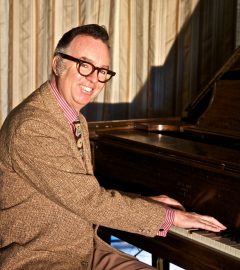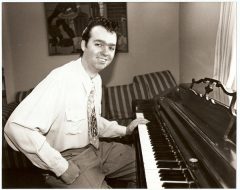Featured Stories
Spotlight on Carl Sonny Leyland at S.D. Jazz Fest’s 40th Anniversary
Located in the South East of England, Southampton is a city that exudes pride in both its storied past and its more contemporary history. It is a tourist magnet for vacationers who flock to gaze at vessels dating back to centuries. Many Sotonians—that’s what the locals call themselves—still look back at 1976, when the former British colonies of North America were celebrating 200 years of freedom from the royal crown and the local football club defeated perennial powerhouse Manchester United to win the F.A. Cup.
A native of the area, Carl Sonny Leyland, didn’t gain fame on the soccer “pitch” but instead carved out an international following for himself for his prowess on the piano. San Diego audiences will have an opportunity to witness his electrifying solo sets and his performances with his own band when Leyland makes his annual trek to the San Diego Jazz Fest, starting Wednesday night, November 27 and continuing through the remainder of the Thanksgiving week.
Leyland, 54, wasn’t the first English kid to discover the roots of American music during his youth. What was being served up as the contemporary music of his teen years left little impression on him; all the better for quality time to see what musical treats the Yanks had preserved on vinyl.
“I grew up about 15 miles outside of Southampton in a semi-rural area known collectively as the Waterside,” Sonny explained. “Specifically I lived in a village called Holbury until I was 14 and from then on in Blackfield, a couple of miles up the road. I was definitely not into the contemporary music of the day. The first thing I liked was ’50s rock ‘n’ roll, which was having a revival at that time (the early to mid-’70s). My dad had some of those LPs, and when I became interested he bought more for me. He also had swing, Dixieland jazz, and old country music in his collection and I listened to all of those styles.
“I started piano right around the time I was turning 15,” said Leyland, “and I was initially inspired by a school friend’s attempt to play a boogie woogie left-hand pattern to a piece called “JD’s Boogie Woogie” [Marvin Wright], read from a beginners’ jazz folio. This friend had an older brother who was an accomplished pianist, mainly classical. After some pleading he agreed to play the boogie piece for me. My mind was blown and I was hooked… I started spending time on the school practice room pianos trying to figure things out. A lucky break was that my dad knew quite a bit about boogie woogie—he had experienced it first hand during the WWII years—and was able to play a few simple things. My parents agreed to buy an old piano so I could practice at home and I continued from there. Another helpful source was a Southampton record shop called Henry’s Records. The manager was a blues fan who had heard many of the greats in person. He had a good stock of blues/boogie LPs and would special-order records by other artists I wanted to hear.
“I made my first public performance three months after I started playing. This took place during the intermission of a Sunday afternoon Dixieland session. About six months in I joined a local blues band. My father contacted the leader, Bob Pearce, and told him that he had a 15-year-old kid who was playing like Otis Spann and Big Maceo. The band performed at a pub called the Onslow Hotel every Saturday night. I auditioned and was hired. Of course, I was green as heck but Bob appreciated that it was something rare and special for a youngster to be into that kind of music.”
Sonny was existing in his musical dream mode during his U.K. years. He eventually made the decision to visit the Big Easy.
“My first visit to the U.S. was in the fall of 1988. I had always felt drawn to this country partly because of my musical tastes and partly because my father, who had visited briefly as a merchant seaman during WWII and spoke well of the place and the people. I chose New Orleans because I had an offer of a place to stay from a touring musician whom I had met the year before in Norway. Of course, I was aware of the city’s musical history but since my specific tastes were in the sounds of the ’40s and ’50s, I didn’t arrive with unrealistic expectations of the place being a musical wonderland. That being said, I quickly discovered that their local radio station, WWOZ, did feature my kind of music frequently. I remember in particular a DJ called Ready Teddy that played a lot of ’50s rock ‘n’ roll and also ‘The Guvner’ who did a two-hour special about one of my favorites, Smiley Lewis. After I had gained some recognition in town I would occasionally be featured on the air since they had a piano in the studio. At that point in my development I was playing mainly blues, rhythm and blues and ’50s rock ‘n’ roll. My initial playing in town was as a sideman with blues bands, in particular with a fellow called Jay Monque’D. A lot of new musicians in town went through his band. He always had gigs although not necessarily in the best places. One joint, Benny’s Bar, did not even have a functioning toilet.
“As soon as I was able I formed my own trio we began to play in and around New Orleans. We did particularly well at a place called Ruby’s Roadhouse located across the Causeway in Mandeville. It was the first time I really recognized the natural function of music. When I would play Fats Domino or Smiley Lewis tunes the dance floor would be full of couples. This was not a ‘swing dance scene,’ but just regular folk who felt like moving to that kind of music. There was nothing artificial or contrived about it. It was as real as it gets. This was a high point. We just fit really well. It didn’t work everywhere and there were certainly some unpleasant experiences, but I suppose every musician who has come up playing in ‘joints’ and ‘dives’ has experienced similar variations. Among other gigs I played in New Orleans were solo piano engagements on Bourbon Street, which is, of course, the center of the tourist-driven entertainment industry in that town. I recall my most intense experience in that location being the sea of humanity that surges through on Mardi Gras day. Honestly, I’m uncomfortable in that setting but I’m glad to have done it once. Stating the obvious, New Orleans is a city with a rich musical history and culture but this is counter balanced by the tourist trade, which tends to dumb things down. I enjoyed the time I spent there but eventually arrived at the point where I needed to try somewhere different. Around 1994 I joined and gained my first touring experience with a blues band from Dallas called Anson Funderburgh and the Rockets, featuring Sam Myers. Anson is an outstanding blues guitarist and Sam was a great harmonica player and singer who had recorded in the 1950s. He had also been a part of Elmore James’ band.”
California’s lure for Sonny came during the ’90s. “A member of the Santa Barbara Blues Society, Las Kiraly, saw me perform at the New Orleans Jazz and Heritage Festival and asked me to come out for a short tour. Not long after that I decided to make the move. A couple of English friends had moved to Los Angeles and were playing with Big Sandy and his Fly-Rite Boys. I was still somewhat captivated with the rockabilly scene and counter culture, which I had been involved with in my youth back in England. Consequently, I very much wanted to be a part of what Big Sandy had going on in Southern California. I spent three a half years with Big Sandy. There was a lot of fun and excitement along the way but as anyone who has toured can tell you, it can be tiring, mentally and physically. In the midst of it all I went through a separation with my first wife, which, to say the least, soured me for a time. Toward the end of my time with Big Sandy I was steadily becoming more driven to play jazz. When I was home from the road I would go hear a New Orleans revival-style band called Gremoli who performed weekly in Orange, California. I started sitting in with them and built up a repertoire of old time jazz tunes while adapting my playing style to that music. When I parted ways with Big Sandy I made my first inroads to the traditional jazz festival scene. Desmond Warren, a guy who had helped me move out from New Orleans connected me with the San Diego Thanksgiving Jazz Festival and from being seen there I was able to get hired by other similar festivals. A lot of help came from Hal Smith, who is the artistic director at SDJF. He played drums in my trio for some years and recommended me to a number of festivals. Since that time I have continued to play a number of Traditional Jazz festivals each year. I also appear at ragtime piano festivals and house concerts. Once in a while I am still called upon to participate in rockabilly events such as Viva Las Vegas where I have been part of the house band for over 20 years.”
Sharing his musical knowledge is part of Leyland’s mission. “I have a weekly radio show called The Rhythm Retrospective, which airs from KCBX San Luis Obispo and KCSM San Mateo. I generally go to Europe once or twice a year. In recent times I have played in Spain, Denmark, Holland, Germany, and even Transylvania, Romania. I’ve also been to Japan, a place that I particularly enjoy. Performing music for a living is a strange business with a large variation of positive and negative experiences.
Based on his proven track record during the many years he has played the San Diego Jazz Fest as a solo cat and as a group leader, we can predict that Leyland will have audiences captivated by his song choices in his sets. This also goes for other veteran performers of the San Diego Jazz Fest, home grown talent like Sue Palmer’s Motel Swing Orchestra and the High Society Jazz Band. And don’t forget Saturday night’s swing dance marathon!
The 40th annual San Diego Jazz Fest will be held at the Town and Country Convention Center in Mission Valley from Wednesday, Nov. 27 to Sunday, Dec.1. Visit sdjazzfest.org for tickets.








